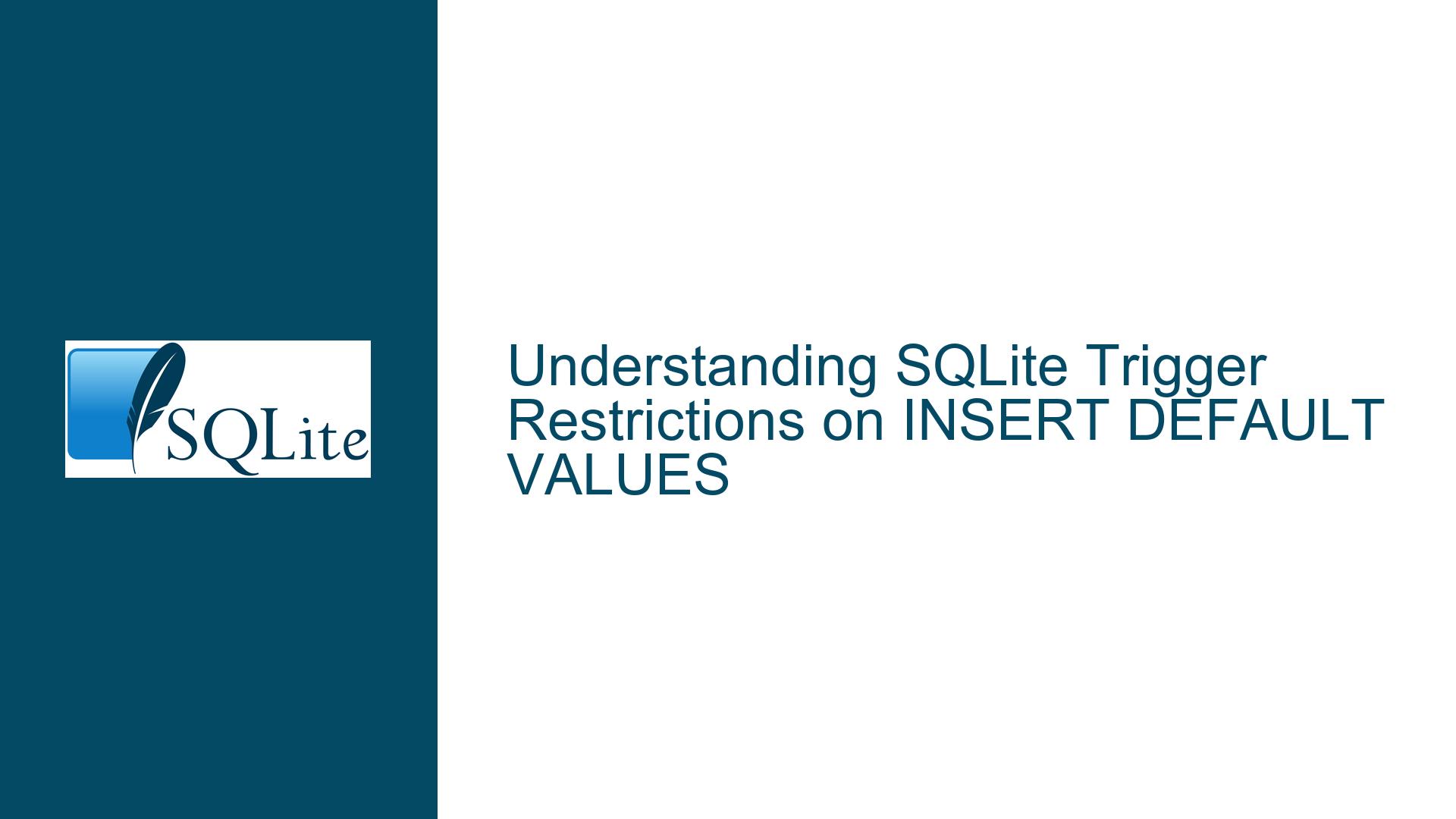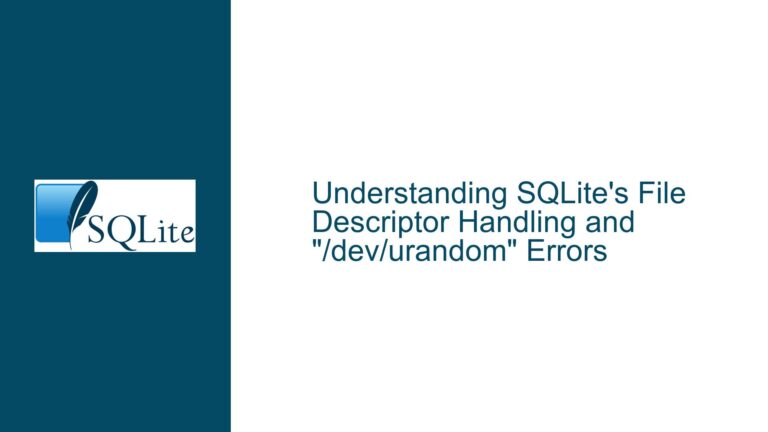SQLite Trigger Restrictions on INSERT DEFAULT VALUES
SQLite Trigger Syntax Error with INSERT DEFAULT VALUES
When working with SQLite, one of the most common tasks is inserting data into tables. The INSERT INTO ... DEFAULT VALUES statement is a convenient way to insert a row with all default values. However, when attempting to use this statement within a trigger, you may encounter a syntax error. This issue arises due to specific restrictions in SQLite’s implementation of triggers and the INSERT DEFAULT VALUES syntax. Understanding why this error occurs and how to work around it is crucial for database developers who rely on triggers for automating data manipulation tasks.
The error message typically encountered is:
SQL Error: near "DEFAULT": syntax error
This error indicates that the SQLite parser does not recognize the DEFAULT keyword in the context of a trigger. This behavior is explicitly documented in SQLite’s official documentation, but it can still be confusing for developers who are not familiar with the nuances of SQLite’s trigger implementation. The core issue lies in the way SQLite handles the INSERT DEFAULT VALUES statement within triggers, which differs from its behavior in standalone SQL statements.
Mismatch Between Trigger Logic and INSERT DEFAULT VALUES
The primary reason for the syntax error when using INSERT DEFAULT VALUES within a trigger is a mismatch between the expected behavior of the trigger and the actual implementation of the INSERT DEFAULT VALUES statement. In SQLite, triggers are designed to execute a set of SQL statements in response to specific events, such as INSERT, UPDATE, or DELETE operations on a table. However, the INSERT DEFAULT VALUES statement is not fully supported within the context of a trigger due to the way SQLite parses and executes trigger logic.
When you create a trigger in SQLite, the trigger body is parsed and compiled into a set of instructions that the SQLite engine can execute. The INSERT DEFAULT VALUES statement, however, is not recognized as a valid statement within this context. This is because the DEFAULT keyword is not treated as a valid value specification within the trigger’s SQL parsing logic. As a result, the SQLite engine throws a syntax error when it encounters the DEFAULT keyword in the trigger body.
Another factor contributing to this issue is the potential for recursive trigger execution. If the INSERT DEFAULT VALUES statement were allowed within a trigger, it could lead to infinite recursion in certain scenarios. For example, if the trigger is defined to fire on an INSERT operation, and the trigger itself performs an INSERT operation, this could create a loop where the trigger keeps firing indefinitely. To prevent such scenarios, SQLite imposes restrictions on the use of certain statements within triggers, including the INSERT DEFAULT VALUES statement.
Implementing Workarounds for INSERT DEFAULT VALUES in Triggers
Given the restrictions on using INSERT DEFAULT VALUES within triggers, developers need to implement alternative approaches to achieve the desired behavior. One common workaround is to explicitly specify the columns and values to be inserted, rather than relying on the DEFAULT keyword. This approach involves defining a dummy column in the table and inserting a NULL value into that column, effectively achieving the same result as INSERT DEFAULT VALUES.
For example, consider the following table definition:
CREATE TABLE ABC (
id INTEGER PRIMARY KEY AUTOINCREMENT,
dummy_column TEXT
);
In this table, dummy_column is a column that can be used to insert a NULL value, effectively simulating the behavior of INSERT DEFAULT VALUES. The trigger can then be modified to insert a NULL value into this column:
CREATE TRIGGER T AFTER UPDATE ON ABC
FOR EACH ROW
BEGIN
INSERT INTO ABC (dummy_column) VALUES (NULL);
END;
This approach avoids the syntax error by explicitly specifying the column and value to be inserted, rather than relying on the DEFAULT keyword. While this workaround requires additional table schema modifications, it provides a viable solution for achieving the desired behavior within triggers.
Another approach is to use the NEW and OLD keywords within the trigger to reference the values of the row being updated. This allows the trigger to insert a new row with specific values derived from the updated row. For example:
CREATE TRIGGER T AFTER UPDATE ON ABC
FOR EACH ROW
BEGIN
INSERT INTO ABC (column1, column2) VALUES (NEW.column1, NEW.column2);
END;
In this example, the trigger inserts a new row into the ABC table with values derived from the NEW keyword, which represents the updated row. This approach allows for more complex logic within the trigger, enabling developers to achieve a wide range of data manipulation tasks.
In some cases, it may be necessary to use a combination of these approaches to achieve the desired behavior. For example, if the table has multiple columns with default values, you may need to explicitly specify the columns and values to be inserted, while also using the NEW and OLD keywords to reference the values of the updated row.
It’s also important to consider the performance implications of using triggers in SQLite. Triggers can introduce additional overhead, especially if they perform complex operations or if they are defined to fire on frequently executed statements. To minimize the performance impact, it’s recommended to keep trigger logic as simple as possible and to avoid unnecessary operations within the trigger body.
In conclusion, while the INSERT DEFAULT VALUES statement is not supported within SQLite triggers, there are several workarounds available to achieve similar behavior. By explicitly specifying the columns and values to be inserted, or by using the NEW and OLD keywords to reference the values of the updated row, developers can implement triggers that perform the desired data manipulation tasks. Additionally, it’s important to consider the performance implications of using triggers and to optimize trigger logic to minimize overhead. With these considerations in mind, developers can effectively work around the limitations of INSERT DEFAULT VALUES within SQLite triggers and achieve the desired behavior in their database applications.






